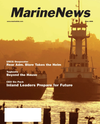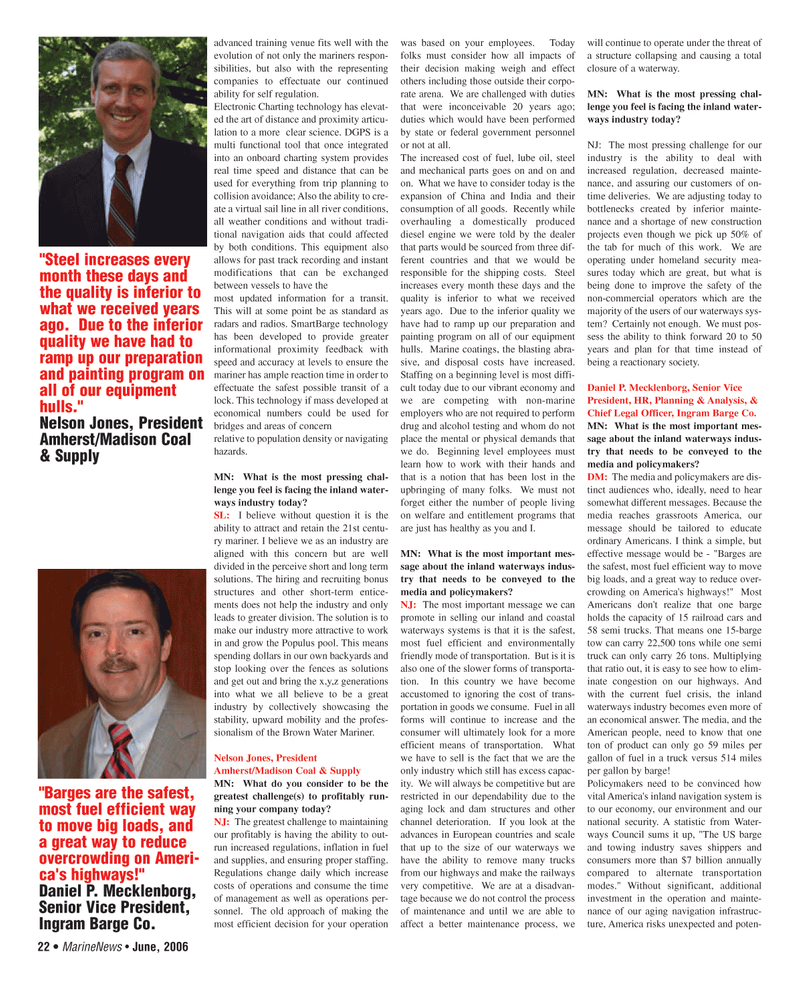
Page 22: of Marine News Magazine (June 2006)
Fourth Annual "Geo Six Pack"
Read this page in Pdf, Flash or Html5 edition of June 2006 Marine News Magazine
advanced training venue fits well with the evolution of not only the mariners respon- sibilities, but also with the representing companies to effectuate our continued ability for self regulation.
Electronic Charting technology has elevat- ed the art of distance and proximity articu- lation to a more clear science. DGPS is a multi functional tool that once integrated into an onboard charting system provides real time speed and distance that can be used for everything from trip planning to collision avoidance; Also the ability to cre- ate a virtual sail line in all river conditions, all weather conditions and without tradi- tional navigation aids that could affected by both conditions. This equipment also allows for past track recording and instant modifications that can be exchanged between vessels to have the most updated information for a transit.
This will at some point be as standard as radars and radios. SmartBarge technology has been developed to provide greater informational proximity feedback with speed and accuracy at levels to ensure the mariner has ample reaction time in order to effectuate the safest possible transit of a lock. This technology if mass developed at economical numbers could be used for bridges and areas of concern relative to population density or navigating hazards.
MN: What is the most pressing chal- lenge you feel is facing the inland water- ways industry today?
SL: I believe without question it is the ability to attract and retain the 21st centu- ry mariner. I believe we as an industry are aligned with this concern but are well divided in the perceive short and long term solutions. The hiring and recruiting bonus structures and other short-term entice- ments does not help the industry and only leads to greater division. The solution is to make our industry more attractive to work in and grow the Populus pool. This means spending dollars in our own backyards and stop looking over the fences as solutions and get out and bring the x,y,z generations into what we all believe to be a great industry by collectively showcasing the stability, upward mobility and the profes- sionalism of the Brown Water Mariner.
Nelson Jones, President
Amherst/Madison Coal & Supply
MN: What do you consider to be the greatest challenge(s) to profitably run- ning your company today?
NJ: The greatest challenge to maintaining our profitably is having the ability to out- run increased regulations, inflation in fuel and supplies, and ensuring proper staffing.
Regulations change daily which increase costs of operations and consume the time of management as well as operations per- sonnel. The old approach of making the most efficient decision for your operation was based on your employees. Today folks must consider how all impacts of their decision making weigh and effect others including those outside their corpo- rate arena. We are challenged with duties that were inconceivable 20 years ago; duties which would have been performed by state or federal government personnel or not at all.
The increased cost of fuel, lube oil, steel and mechanical parts goes on and on and on. What we have to consider today is the expansion of China and India and their consumption of all goods. Recently while overhauling a domestically produced diesel engine we were told by the dealer that parts would be sourced from three dif- ferent countries and that we would be responsible for the shipping costs. Steel increases every month these days and the quality is inferior to what we received years ago. Due to the inferior quality we have had to ramp up our preparation and painting program on all of our equipment hulls. Marine coatings, the blasting abra- sive, and disposal costs have increased.
Staffing on a beginning level is most diffi- cult today due to our vibrant economy and we are competing with non-marine employers who are not required to perform drug and alcohol testing and whom do not place the mental or physical demands that we do. Beginning level employees must learn how to work with their hands and that is a notion that has been lost in the upbringing of many folks. We must not forget either the number of people living on welfare and entitlement programs that are just has healthy as you and I.
MN: What is the most important mes- sage about the inland waterways indus- try that needs to be conveyed to the media and policymakers?
NJ: The most important message we can promote in selling our inland and coastal waterways systems is that it is the safest, most fuel efficient and environmentally friendly mode of transportation. But is it is also one of the slower forms of transporta- tion. In this country we have become accustomed to ignoring the cost of trans- portation in goods we consume. Fuel in all forms will continue to increase and the consumer will ultimately look for a more efficient means of transportation. What we have to sell is the fact that we are the only industry which still has excess capac- ity. We will always be competitive but are restricted in our dependability due to the aging lock and dam structures and other channel deterioration. If you look at the advances in European countries and scale that up to the size of our waterways we have the ability to remove many trucks from our highways and make the railways very competitive. We are at a disadvan- tage because we do not control the process of maintenance and until we are able to affect a better maintenance process, we will continue to operate under the threat of a structure collapsing and causing a total closure of a waterway.
MN: What is the most pressing chal- lenge you feel is facing the inland water- ways industry today?
NJ: The most pressing challenge for our industry is the ability to deal with increased regulation, decreased mainte- nance, and assuring our customers of on- time deliveries. We are adjusting today to bottlenecks created by inferior mainte- nance and a shortage of new construction projects even though we pick up 50% of the tab for much of this work. We are operating under homeland security mea- sures today which are great, but what is being done to improve the safety of the non-commercial operators which are the majority of the users of our waterways sys- tem? Certainly not enough. We must pos- sess the ability to think forward 20 to 50 years and plan for that time instead of being a reactionary society.
Daniel P. Mecklenborg, Senior Vice
President, HR, Planning & Analysis, &
Chief Legal Officer, Ingram Barge Co.
MN: What is the most important mes- sage about the inland waterways indus- try that needs to be conveyed to the media and policymakers?
DM: The media and policymakers are dis- tinct audiences who, ideally, need to hear somewhat different messages. Because the media reaches grassroots America, our message should be tailored to educate ordinary Americans. I think a simple, but effective message would be - "Barges are the safest, most fuel efficient way to move big loads, and a great way to reduce over- crowding on America's highways!" Most
Americans don't realize that one barge holds the capacity of 15 railroad cars and 58 semi trucks. That means one 15-barge tow can carry 22,500 tons while one semi truck can only carry 26 tons. Multiplying that ratio out, it is easy to see how to elim- inate congestion on our highways. And with the current fuel crisis, the inland waterways industry becomes even more of an economical answer. The media, and the
American people, need to know that one ton of product can only go 59 miles per gallon of fuel in a truck versus 514 miles per gallon by barge!
Policymakers need to be convinced how vital America's inland navigation system is to our economy, our environment and our national security. A statistic from Water- ways Council sums it up, "The US barge and towing industry saves shippers and consumers more than $7 billion annually compared to alternate transportation modes." Without significant, additional investment in the operation and mainte- nance of our aging navigation infrastruc- ture, America risks unexpected and poten- "Steel increases every month these days and the quality is inferior to what we received years ago. Due to the inferior quality we have had to ramp up our preparation and painting program on all of our equipment hulls."
Nelson Jones, President
Amherst/Madison Coal & Supply "Barges are the safest, most fuel efficient way to move big loads, and a great way to reduce overcrowding on Ameri- ca's highways!"
Daniel P. Mecklenborg,
Senior Vice President,
Ingram Barge Co. 22 • MarineNews • June, 2006
JUNE MN2006 3(17-24).qxd 6/2/2006 10:51 AM Page 22

 21
21

 23
23
